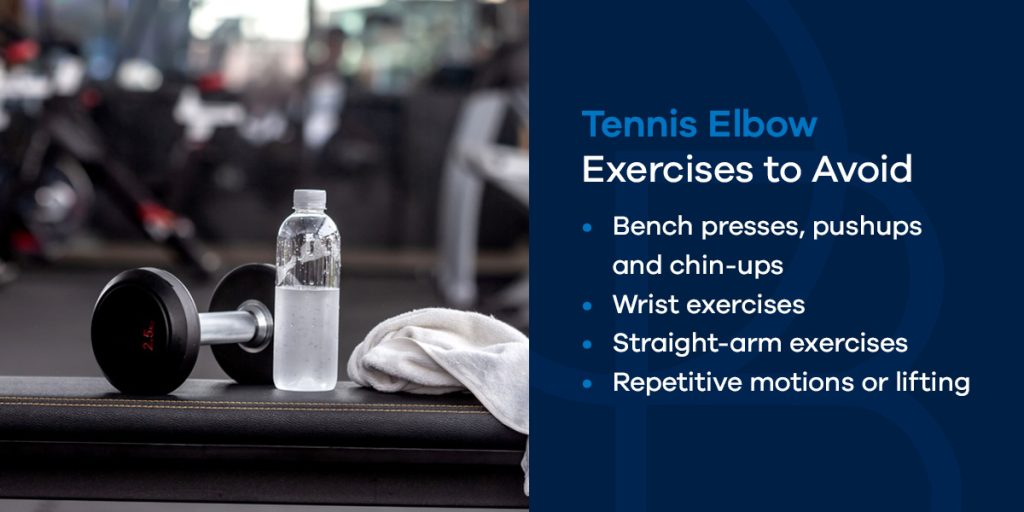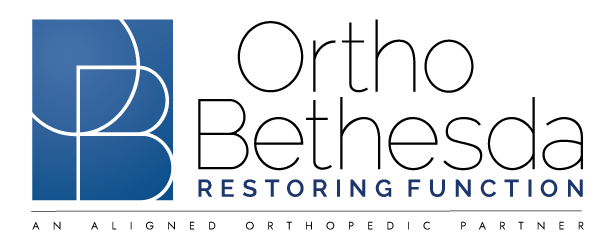
If you’ve been diagnosed with tennis elbow, you’re probably aware of the pain and inflammation associated with this condition. Many of our patients wonder when they can go back to exercising after experiencing a tennis elbow injury. A good rule of thumb is to avoid exercises that cause pain to your arm. However, a few stretches and activities can be beneficial in rehabilitating your muscles and tendons. Some can even help treat tennis elbow pain.
If you’re worried that your activities could exacerbate your injury, pay attention to the top exercises you should avoid if you have tennis elbow.
What Is Tennis Elbow?
Lateral epicondylitis, another name for tennis elbow, is a repetitive stress injury that typically occurs in athletes who overwork the tendons and muscles outside the elbow. However, tennis elbow injuries can also be caused by everyday activities or jobs that require repetitive arm motions.
When someone develops tennis elbow, tendons that allow your wrist to bend back away from your palm cause pain to the forearm and the outside of the elbow. Women and men between 30 and 50 are the most likely to receive a tennis elbow diagnosis. The condition typically heals itself, and most people recover between six months and two years with the proper care.
Signs You May Have Tennis Elbow
Tennis elbow often occurs after overuse, starting slowly and worsening over weeks or months. Identifying the symptoms of tennis elbow can help you intervene early to improve your condition and find relief. Some of the signs of tennis elbow include:
- Pain around the outer elbow: Tennis elbow pain commonly occurs around the outer elbow, sometimes extending to the wrist. Pain may get worse at night but varies from person to person.
- Pain bending or twisting your arm: Moving your arm, whether exercising or doing regular daily activities, can cause pain. Some people feel pain when opening jars, turning doorknobs or doing other everyday activities.
- Loss of grip strength: People with tennis elbow often experience a weak grip when they try to hold items, including sports equipment, pens or even another person’s hand. Weak grip strength can interfere with a person’s ability to perform daily activities.
- Swollen elbow joints: The joints in the elbow can become swollen when the tendons and muscles surrounding them become inflamed or injured. You could have tennis elbow if you notice pain alongside a swollen elbow joint.
- Pain or stiffness: If you experience pain or stiffness around your elbow, forearm or wrist when you extend it, it could be a sign that you have tennis elbow.
Tennis Elbow Exercises
Improving tennis elbow pain can help you return to your regular activities sooner and help your find relief from pain or discomfort. Some of the exercises you can do include:
1. Wrist Extension Stretches
Start by straightening your arm and placing your hand in front of you as if signaling someone to stop. Use your opposite hand to gently pull back your extended hand, applying pressure on the palm. Keep pulling until you feel pressure on the inside of your forearm. You’ll want to hold this stretch for about 15 seconds before releasing it.
You should repeat this stretch five times for each arm, up to four times a day. You can see the best results by performing this stretch five to seven days a week. Remember not to lock your elbow, and complete this stretch as a warm-up before engaging in any activities that require a grip.
2. Wrist Flexion Stretches
This stretch works opposite to the one above. You’ll still straighten your arm in front of you, but you’ll use your opposite hand to pull the top of your hand toward you. You’ll feel this stretch on the top of your wrist and forearm. Hold the stretch for 15 seconds before releasing.
You’ll repeat wrist flexion stretches as often as the wrist extension stretches. Similarly, you should complete these stretches as a warm-up before activities requiring your grip.
3. Stress Ball Exercises
All you’ll need for this exercise is a rubber or foam stress ball. You’ll simply get your arm in the same position as the above exercises and squeeze the ball 10 times. You can do this exercise once daily and gradually increase it as you become more comfortable. You should repeat this exercise at least five days a week on top of your other exercises.
4. Finger Stretches
You’ll need an elastic band for this exercise. If you have a large enough hair tie, you can use it in place of a regular elastic band. Ideally, the band should be able to sit around your four fingers without falling off or being too tight.
Once the elastic is in place, slowly pull your fingers apart. You should feel some resistance in the elastic, which is what helps you stretch. You should complete 10 repetitions for each hand at least once a day, five to seven days a week.

Tennis Elbow Exercises to Avoid
Any activity that causes shooting or sharp pain in your arm or elbow should be avoided altogether. However, before hitting the gym, you may want to take these exercises or workouts out of your routine:
- Bench presses, pushups and chin-ups: These exercises can strain your flexors, further irritating your tennis elbow and worsening your condition.
- Wrist exercises: Many wrist exercises can cause additional stress to your forearm and elbow, worsening your injury and making the pain chronic. Activities you should particularly avoid include barbell extensions and dumbbell curls.
- Straight-arm exercises: Keeping your arms straight and your elbows fully extended can strain your wrist extensor muscles.
- Repetitive motions or lifting: Any repetitive exercise that makes you move your elbow and wrist can cause agitation for your condition. When working on activities for tennis elbow, try to avoid doing too many repetitions when possible.
Other Sports and Activities to Avoid
While tennis elbow was named due to its frequency among racquet players, it can also occur among other athletes. Golfers and swimmers can also sprain the lateral parts of their elbows’ muscles. If you play any of these sports and develop lateral epicondylitis, it’s best to put these sports on hold for a while until the injury heals.
It’s not just exercises and sports that can agitate your tennis elbow symptoms and prolong the recovery process. Several activities rely on repetitive arm motions and should be avoided, as they can cause setbacks for tendon healing, such as:
- Slicing and preparing food
- Painting
- Using a screwdriver
- Excessively using the computer
Tennis Elbow Treatment
Once you’re diagnosed with tennis elbow, you generally have two options for treatment: surgical and non-surgical. Typically, you’ll start with non-surgical treatment to determine if you can improve without invasive treatment. The types of noninvasive treatments include:
- Cortisone injections
- Activity changes
- Shock wave therapy
- Anti-inflammatory and pain medication
- Exercises to improve range of motion
- Physical therapy
- Icing
If you don’t find relief from these treatment methods or your injury is more severe, such as torn ligaments or tendons, your doctor may recommend surgery. There are three predominant types of surgical techniques for tennis elbow:
- Arthroscopic: Arthroscopic surgical techniques are a minimally invasive option that involves a small incision in the elbow, where your surgeon will place a small camera to see the structure of your elbow. Your surgeon will then repair the tendons. This option helps reduce pain and allows for a quick recovery.
- Tendon reconstruction: Your surgeon may need to perform tendon reconstruction, which can help reduce your pain and improve strength and function.
- Open tendon repair: If you have significant damage to your tendons, you may need open tendon repair. This procedure is often for complex damage and injuries, sometimes requiring multiple surgeries to improve a person’s condition.
Like any surgery, you’ll need to spend some time recovering, which includes staying away from activities that could aggravate your condition and increase healing time. You’ll also have to participate in physical therapy to regain your lost strength.

Meet Our Doctors Who Treat the Elbow
If you’re experiencing pain radiating from outside your elbow and down your forearm and wrist, you could have tennis elbow. This injury causes discomfort and is often associated with weakness in performing daily activities, such as holding a cup of coffee or turning a door handle. OrthoBethesda is here to provide premium elbow treatment to patients with these symptoms.
Those living in Bethesda, MD, and the surrounding area are invited to call us at 301-530-1010 or contact us online today. Our orthopedic specialists would be pleased to meet with you to work out a treatment plan that helps target your specific symptoms.
Related Content
- Golfer’s Elbow: What Is Is and How You Can Heal It
- What’s the Difference Between Golfers Elbow and Tennis Elbow
- 7 Tennis Elbow Exercises to Treat Your Pain at Home
- How Long It Takes for Tennis Elbow to Heal
- Exercises You Can Do for Tennis Elbow
- Biceps Tendonitis
- Tenodesis vs. Tenotomy
- Everything to Know About Tommy John Surgery
